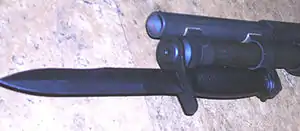Bayonet lug
A bayonet lug is a standard feature on most military muskets, rifles, and shotguns, and on some civilian longarms. It is intended for attaching a bayonet, which is typically a long spike or thrusting knife. The bayonet lug is the metal mount that either locks the bayonet onto the weapon or provides a base for the bayonet to rest against, so that when a bayonet thrust is made, the bayonet does not move or slip backwards. Less than 400 years ago, bayonet lugs or their predecessors that allowed them to slip over the barrel did not exist.

Prior to the lug's invention plug bayonets were used, which were stuffed into the muzzle's end from a tight-fitting stub, rendering the firearm virtually useless and certainly preventing it from being discharged.[1][2] But by the late 17th century, this type of bayonet was entirely phased out and subsequently replaced with the socket bayonet, that slides over the muzzle with the blade offset to the side, just above or underneath. The socket bayonet would be replaced by the press stud and bayonet lug.[3] Bayonet lugs are usually located near the muzzle end of a musket, rifle, or other longarm barrel.[4] The lug is occasionally placed on top of the barrel, if serving as the base of the front sight, or more often mounted to the side or bottom of the barrel.[5][6][7]
Legality
Unlike collection worthy firearms that were military issue, civilian firearms based on their military versions are often subject to legal issues in various states. Many manufacturers do not even bother with making the bayonet lugs. The Assault weapons ban in 1994 issued that new firearms could not have bayonet lugs. In the context of that law, the National Rifle Association deemed telescoping stocks a "cosmetic feature".[8] Most AR uppers for example being sold today do not have bayonet lugs, because they are typically free-float quad-rail setups with hidden gas blocks and no way to attach a bayonet.
See also
- Bayonet mount, a fastening mechanism
References
- Norris, John (2016-01-03). Fix Bayonets!. Pen and Sword. ISBN 978-1-4738-8378-9.
- Jones, Gareth, ed. (2012-10-01). Military History: The Definitive Visual Guide to the Objects of Warfare. DK Publishing. ISBN 978-1-4654-1158-7.
- Bulletin. Vol 24. University of Michigan: Military Historical Society (Great Britain). 1973.
- Office, United States Patent and Trademark (1987). Official Gazette of the United States Patent and Trademark Office: Patents. U.S. Department of Commerce, Patent and Trademark Office.
- Chapel, Charles Edward (2012-05-24). Guns of the Old West: An Illustrated Guide. Courier Corporation. ISBN 978-0-486-16306-2.
- Moller, George D. (2011-11-15). American Military Shoulder Arms, Volume I: Colonial and Revolutionary War Arms. UNM Press. ISBN 978-0-8263-4996-5.
- Pauly, Roger (2008-04-28). Firearms: The Life Story of a Technology. Northwestern University: Johns Hopkins University Press. ISBN 978-0-8018-8836-6.
- "Finally, the End of a Sad Era--Clinton Gun Ban Stricken from Books!". Fairfax, Virginia: National Rifle Association, Institute for Legislative Action. September 13, 2004.
Law-abiding citizens, however, will once again be free to purchase semi-automatic firearms, regardless of their cosmetic features, for target shooting, shooting competitions, hunting, collecting, and most importantly, self-defense.